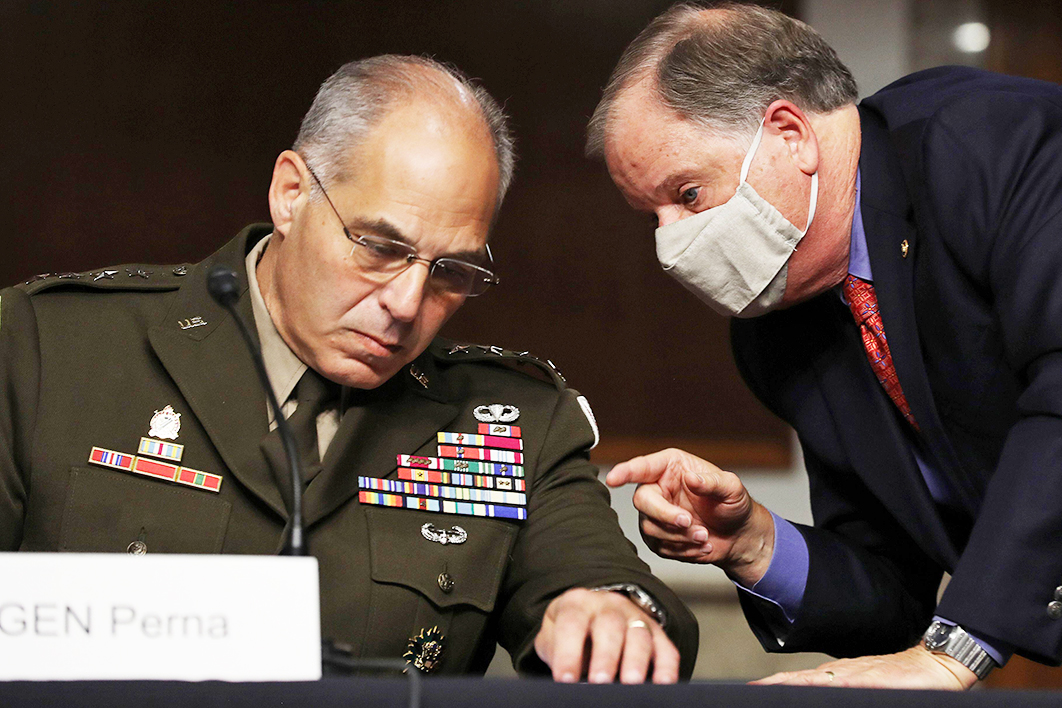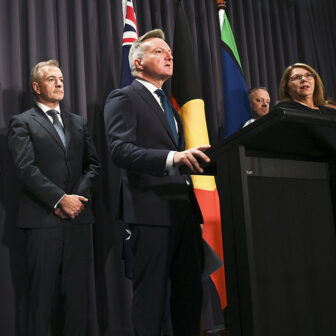Last week prime minister Scott Morrison made a very deliberate pivot to optimism. “Hope” was the word of the day on 19 August when he announced a letter of intent had been signed with pharmaceutical company AstraZeneca for Australian production of the Covid-19 vaccine the company is developing with Oxford University, assuming it proves successful. Just in case the message didn’t get through, Morrison repeated the word hope — about vaccines, about Victoria’s improving figures — three times in the first minute of his press conference following the national cabinet meeting on 21 August.
This calculated shift leverages Victoria’s apparent success in curbing a Covid-19 upsurge that had peaked on 7 August at nearly 7000 active cases. That experience has been an object lesson in the dynamics of this epidemic — undetected transmissions getting out of hand within days and, once established, requiring massively curtailed movement and the tracking down of everyone to whom the virus has spread.
Other states are crossing their fingers they won’t experience anything on that scale. But avoiding outbreaks altogether is almost certainly a vain hope. Resurgent epidemics across Europe and in South Korea, and even the reappearance of cases in New Zealand after 102 “Covid-free” days, show the virus will relentlessly exploit uninfected populations. With 23.5 million reported cases globally and the real number of infections running at ten times that, attempts at elimination are futile. SARS-CoV-2 has established itself as a permanent part of the human condition.
Still an open question, though, is how much Covid-19 will contribute to the total human burden of disease, and here there is everything to play for. Hence the prime minister’s pivot to vaccine optimism.
Back in March and April, prognostications about a Covid-19 vaccine were cautious. No one wanted to repeat the mistake made with AIDS, for which a vaccine was promised “within months” back in 1984. Even today, despite a massive scientific effort, that vaccine remains elusive. But the mood around a Covid-19 vaccine began to change midyear, and by the end of July was buoyantly optimistic. At least four of the leading candidates had by then announced results of phase I and II trials that showed safe and well-tolerated products producing strong immune reactions.
But with success on the horizon, things began to get murky. First came a rush to lock in vaccine pre-orders, riding roughshod over the World Health Organization’s attempt to secure agreement on equitable and orderly distribution, as part of a plan to cooperatively accelerate and scale up every step from discovery to access. Leading the scramble for primacy was the United States, forcing other countries to place orders or establish special relationships with vaccine developers before future supplies were fully committed.
Vaccine nationalism also infected the race for vaccine discovery, with the tone again set by the United States. When he launched the US vaccine development effort Operation Warp Speed in May, Donald Trump spent more time talking up the American military than he did vaccines. It may have escaped attention that Operation Warp Speed is jointly run by the US Department of Health and the Department of Defense, with army general Gustave Perna as its chief operating officer. US vaccine partnerships are a mirror of its military stance: having failed back in March to buy up German vaccine company CureVac and move it to the United States, the Americans are having to spend a lot of money securing alliances with European and British vaccine developers.
Meanwhile, in a reversion to cold war tropes, Russia has named its Covid-19 vaccine Sputnik V. But an even greater risk to global cooperation in this new cold war is Trump’s refusal to contemplate any cooperation with Chinese vaccine development, a stance he may soon come to rue. At least three of the Chinese candidates are among the most advanced.
The biggest threat now to Covid-19 vaccine development is that the science of proving vaccine effectiveness will be subordinated to politico-military considerations.
On Sunday, on the eve of the Republican National Convention, Trump announced emergency-use authorisation of blood plasma as a Covid-19 treatment. Given that large-scale trials were already under way, this move smacked of desperation. Australia’s CSL boss Paul Perreault participated in a White House roundtable on using plasma back in July, and upwards of 30,000 patients are already being treated under the trials, which is probably around the maximum capacity for the therapy. Trump’s announcement offered no material advantage, though something will be lost if the plasma treatment is prescribed as standard care rather than as part of a carefully evaluated trial.
The emergency-use authorisation is itself a product of a militarisation of the health response. Introduced by the Project BioShield Act of 2004, it goes beyond the US Food and Drug Administration’s earlier processes for speedy authorisation of drugs under investigation, which had been much accelerated under pressure from AIDS activists at the end of the 1980s.
Amid the concerns about biological warfare during the “war on terror,” the United States felt the need for a drug or vaccine authorisation process more attuned to the scale of an attack. The current procedure was first used in 2005 after notorious security hawk Paul Wolfowitz, then deputy defense secretary, sought authority to deploy an anthrax vaccine against the imminent threat of an anthrax attack. Trump’s use of the authorisation for blood plasma is clearly a rehearsal for its use to authorise a Covid-19 vaccine on the eve of the US election.
When McKinsey and Company reviewed the increasingly optimistic vaccine landscape at the end of July, it noted that six vaccine developers had already signalled their intention to use some form of emergency authorisation for their products towards the end of 2020. The earliest candidate was from Oxford–AstraZeneca, signalling a September–October time frame for emergency use, followed by Pfizer–BioNTech in October, Moderna in the last quarter of 2020, and two of the candidates from Chinese developer Sinopharm in December.
The orthodox account of vaccine or drug development is that, having established safety and proof-of-concept efficacy in phases I and II, the effectiveness of the treatment is demonstrated in a phase I trial. Treatments are meant to move to regulatory approval only if they pass the effectiveness threshold in phase III.
The national and geopolitical pressures on a Covid-19 vaccine are blurring these lines. To shorten the time in which a vaccine can prove its effectiveness, the numbers enrolled in some of the phase III trials have already become massive — 60,000 for a Johnson & Johnson trial beginning in September, 30,000 each for Moderna’s and Pfizer’s.
Russia seems to have approved use of the vaccine developed by the Gamaleya Institute in advance of formal phase III trials, which are only just beginning. Meanwhile, China’s National Health Commission reported on 24 August that Covid-19 vaccines developed by Chinese companies had been authorised for emergency use back in July.
Last week’s vaccine optimism from Scott Morrison was accompanied by an avuncular promise of Australian largesse to extend vaccine access to the “Pacific family.” The PM may find that announcement is too little too late, given that three of the six vaccines already in phase III trials are from Australia’s rival in the Pacific, China, with two more, equally promising, Chinese products following closely behind.
As the vaccine scramble intensifies, so too will the challenge of sorting good data from bad. A pandemic vaccine ought to be the ultimate global public good, but when a powerful state not only uses its purchasing power to try to corner the market but also compromises the integrity of the scientific discovery process in the service of a political timetable, it turns the vaccine into a global public bad.
It may not be too late to rescue good science. Vaccine candidates need to be held to transparent and rigorously applied standards of proof against established criteria. A massive effort will be needed to hold to this core of truth while the inevitable emergency authorisations, and commercial and geopolitical brand-positioning are swirling around. Ultimately, though, this is the only strategy that will stand the test of time.
Australia’s accomplishment in keeping the number of Covid-19 infections low will give it the luxury of rolling out vaccination carefully. Priorities can be set according to need, and emerging hotspots dealt with by combining targeted vaccination with existing techniques of testing, contact tracing and isolation.
Importantly, flicking the switch to hope should not end the national conversations that Covid-19 has started. We have had a glimpse of what a better system of income support might look like, free of the impulse to punish the unemployed so they accept their status as a reserve army of labour. The shortcomings of a care economy grounded in underpayment (it was, after all, women’s work) have been laid bare and can now perhaps be repaired. These are opportunities to build back better, not snap back to worse. •




